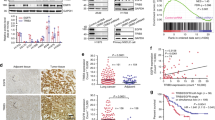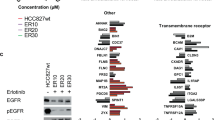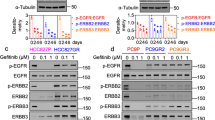Abstract
The epidermal growth factor receptor (EGFR) is overexpressed and activated in many human cancers and predicts poor patient prognosis. Targeting the kinase domain with specific EGFR tyrosine kinase inhibitors (TKIs) like gefitinib and erlotinib has been used in anticancer treatments. However, patient response rates in different human cancers were initially low. Only a subgroup of non-small-cell lung cancer (NSCLC) patients harboring EGFR-activating mutations responds to EGFR TKI treatment, but most of these responders relapse and acquire resistance. Recent clinical studies have demonstrated that MET proto-oncogene overexpression correlates with resistance to EGFR TKI treatment. Similarly to MET overexpression, the tumor microenvironment-derived ligand hepatocyte growth factor (HGF) was shown to activate Met and thereby induce short-term resistance to EGFR TKI treatment in gefitinib-sensitive NSCLC cell lines in vitro. However, only little is known about the HGF/Met-induced EGFR TKI resistance mechanism in other human cancer types. Therefore, in order to develop possible new anticancer strategies for diverse human cancers, we screened 12 carcinoma cell lines originating from the breast, kidney, liver and tongue for HGF-induced EGFR tyrosine kinase (TK)-inhibition. In addition, in order to advance our understanding of a TK-inactive EGFR, we used EGFR co-immunoprecipitation, followed by mass spectrometry to identify novel HGF-induced EGFR binding partners, which are potentially involved in tyrosine kinase-independent EGFR signaling mechanisms. Here we show for the first time that HGF-induced EGFR TK-inhibition is a very common mechanism in human cancers, and that the kinase-inactive EGFR directly interacts with and stabilizes several cancer-relevant proteins, including the receptor tyrosine kinases Axl and EphA2, and the CUB domain-containing protein-1. This study has strong implications for the development of new anticancer strategies.
This is a preview of subscription content, access via your institution
Access options
Subscribe to this journal
Receive 50 print issues and online access
$259.00 per year
only $5.18 per issue
Buy this article
- Purchase on Springer Link
- Instant access to full article PDF
Prices may be subject to local taxes which are calculated during checkout







Similar content being viewed by others
References
Nicholson RI, Gee JM, Harper ME . EGFR and cancer prognosis. J Cancer 2001; 37 (Suppl 4): S9–S15.
Huang SM, Harari PM . Epidermal growth factor receptor inhibition in cancer therapy: biology, rationale and preliminary clinical results. Invest New Drugs 1999; 17: 259–269.
Mitsudomi T, Yatabe Y . Epidermal growth factor receptor in relation to tumor development: EGFR gene and cancer. FEBS J 2010; 277: 301–308.
Gschwind A, Fischer OM, Ullrich A . The discovery of receptor tyrosine kinases: targets for cancer therapy. Nat Rev Cancer 2004; 4: 361–370.
Hynes NE, Lane HA . ERBB Receptors and cancer: the complexity of targeted inhibitors. Nat Rev Cancer 2005; 5: 341–354.
Castillo L, Etienne-Grimaldi MC, Fischel JL, Formento P, Magne N, Milano G . Pharmacological background of EGFR targeting. Ann Oncol 2004; 15: 1007–1012.
Salomon DS, Brandt R, Ciardiello F, Normanno N . Epidermal growth factor-related peptides and their receptors in human malignancies. Crit Rev Oncol Hematol 1995; 19: 183–232.
Franovic A, Gunaratnam L, Smith K, Robert I, Patten D, Lee S . Translational up-regulation of the EGFR by tumor hypoxia provides a nonmutational explanation for its overexpression in human cancer. Proc Nat Acad Sci USA 2007; 104: 13092–13097.
Laimer K, Spizzo G, Gastl G, Obrist P, Brunhuber T, Fong D et al. High EGFR expression predicts poor prognosis in patients with squamous cell carcinoma of the oral cavity and oropharynx: a TMA-based immunohistochemical analysis. Oral Oncol 2007; 43: 193–198.
Olayioye MA, Neve RM, Lane HA, Hynes NE . The ErbB signaling network: receptor heterodimerization in development and cancer. EMBO J 2000; 19: 3159–3167.
Harris RC, Chung E, Coffey RJ . EGF receptor ligands. Exp Cell Res 2003; 284: 2–13.
Burgess AW, Cho HS, Eigenbrot C, Ferguson KM, Garrett TP, Leahy DJ et al. An open-and-shut case? Recent insights into the activation of EGF/ErbB receptors. Mol Cell 2003; 12: 541–552.
Schlessinger J . Cell signaling by receptor tyrosine kinases. Cell 2000; 103: 211–225.
Quesnelle KM, Boehm AL, Grandis JR . STAT-mediated EGFR signaling in cancer. J Cell Biochem 2007; 102: 311–319.
Schlessinger J . Common and distinct elements in cellular signaling via EGF and FGF receptors. Science 2004; 306: 1506–1507.
Citri A, Yarden YEGF-ERBB . Signalling: towards the systems level. Nat Rev Mol Cell Biol 2006; 7: 505–516.
Lurje G, Lenz HJ . EGFR signaling and drug discovery. Oncology. 2009; 77: 400–410.
Blagosklonny MV, Darzynkiewicz Z . Why Iressa failed: toward novel use of kinase inhibitors (outlook). Cancer Biol Ther 2003; 2: 137–140.
Twombly R . Failing survival advantage in crucial trial, future of Iressa is in jeopardy. J Natl Cancer Inst 2005; 97: 249–250.
Dickler MN, Cobleigh MA, Miller KD, Klein PM, Winer EP . Efficacy and safety of erlotinib in patients with locally advanced or metastatic breast cancer. Breast Cancer Res Treat 2009; 115: 115–121.
Gordon AN, Finkler N, Edwards RP, Garcia AA, Crozier M, Irwin DH et al. Efficacy and safety of erlotinib HCl, an epidermal growth factor receptor (HER1/EGFR) tyrosine kinase inhibitor, in patients with advanced ovarian carcinoma: results from a phase II multicenter study. Int J Gynecol Cancer 2005; 15: 785–792.
Lynch TJ, Bell DW, Sordella R, Gurubhagavatula S, Okimoto RA, Brannigan BW et al. Activating mutations in the epidermal growth factor receptor underlying responsiveness of non-small-cell lung cancer to gefitinib. N Engl J Med 2004; 350: 2129–2139.
Balak MN, Gong Y, Riely GJ, Somwar R, Li AR, Zakowski MF et al. Novel D761Y and common secondary T790M mutations in epidermal growth factor receptor-mutant lung adenocarcinomas with acquired resistance to kinase inhibitors. Clin Cancer Res 2006; 12: 6494–6501.
Engelman JA, Zejnullahu K, Mitsudomi T, Song Y, Hyland C, Park JO et al. MET amplification leads to gefitinib resistance in lung cancer by activating ERBB3 signaling. Science 2007; 316: 1039–1043.
Pao W, Miller VA, Politi KA, Riely GJ, Somwar R, Zakowski MF et al. Acquired resistance of lung adenocarcinomas to gefitinib or erlotinib is associated with a second mutation in the EGFR kinase domain. PLoS Med 2005; 2: e73.
Yoshida T, Zhang G, Haura EB . Targeting epidermal growth factor receptor. Central signaling kinase in lung cancer. Biochem Pharmacol 2010; 80: 613–623.
Xu L, Nilsson MB, Saintigny P, Cascone T, Herynk MH, Du Z et al. Epidermal growth factor receptor regulates MET levels and invasiveness through hypoxia-inducible factor-1alpha in non-small cell lung cancer cells. Oncogene 2010; 29: 2616–2627.
Zucali PA, Ruiz MG, Giovannetti E, Destro A, Varella-Garcia M, Floor K et al. Role of cMET expression in non-small-cell lung cancer patients treated with EGFR tyrosine kinase inhibitors. Ann Oncol 2008; 19: 1605–1612.
Bean J, Brennan C, Shih JY, Riely G, Viale A, Wang L et al. MET amplification occurs with or without T790M mutations in EGFR mutant lung tumors with acquired resistance to gefitinib or erlotinib. Proc Nat Acad Sci USA 2007; 104: 20932–20937.
Chen HJ, Mok TS, Chen ZH, Guo AL, Zhang XC, Su J et al. Clinicopathologic and molecular features of epidermal growth factor receptor T790M mutation and c-MET amplification in tyrosine kinase inhibitor-resistant Chinese non-small cell lung cancer. Pathol Oncol Res 2009; 15: 651–658.
Wang W, Li Q, Yamada T, Matsumoto K, Matsumoto I, Oda M et al. Crosstalk to stromal fibroblasts induces resistance of lung cancer to epidermal growth factor receptor tyrosine kinase inhibitors. Clin Cancer Res 2009; 15: 6630–6638.
Kawaguchi K, Murakami H, Taniguchi T, Fujii M, Kawata S, Fukui T et al. Combined inhibition of MET and EGFR suppresses proliferation of malignant mesothelioma cells. Carcinogenesis 2009; 30: 1097–1105.
Birchmeier C, Birchmeier W, Gherardi E, Vande WGF . Met, metastasis, motility and more. Nat Rev Mol Cell Biol 2003; 4: 915–925.
Weinberger PM, Yu Z, Kowalski D, Joe J, Manger P, Psyrri A et al. Differential expression of epidermal growth factor receptor, c-Met, and HER2/neu in chordoma compared with 17 other malignancies. Arch Otolaryngol Head Neck Surg 2005; 131: 707–711.
Pai R, Nakamura T, Moon WS, Tarnawski AS . Prostaglandins promote colon cancer cell invasion; signaling by cross-talk between two distinct growth factor receptors. FASEB J 2003; 17: 1640–1647.
Peghini PL, Iwamoto M, Raffeld M, Chen YJ, Goebel SU, Serrano J et al. Overexpression of epidermal growth factor and hepatocyte growth factor receptors in a proportion of gastrinomas correlates with aggressive growth and lower curability. Clin Cancer Res 2002; 8: 2273–2285.
Wheeler DL, Huang S, Kruser TJ, Nechrebecki MM, Armstrong EA, Benavente S et al. Mechanisms of acquired resistance to cetuximab: role of HER (ErbB) family members. Oncogene 2008; 27: 3944–3956.
Tlsty TD, Coussens LM . Tumor stroma and regulation of cancer development. Annu Rev Pathol 2006; 1: 119–150.
Arteaga CL . Epidermal growth factor receptor dependence in human tumors: more than just expression? Oncologist 2002; 7 (Suppl 4): 31–39.
Reznik TE, Sang Y, Ma Y, Abounader R, Rosen EM, Xia S et al. Transcription-dependent epidermal growth factor receptor activation by hepatocyte growth factor. Mol Cancer Res 2008; 6: 139–150.
Spix JK, Chay EY, Block ER, Klarlund JK . Hepatocyte growth factor induces epithelial cell motility through transactivation of the epidermal growth factor receptor. Exp Cell Res 2007; 313: 3319–3325.
Tice DA, Biscardi JS, Nickles AL, Parsons SJ . Mechanism of biological synergy between cellular Src and epidermal growth factor receptor. Proc Nat Acad Sci USA 1999; 96: 1415–1420.
Levkowitz G, Waterman H, Ettenberg SA, Katz M, Tsygankov AY, Alroy I et al. Ubiquitin ligase activity and tyrosine phosphorylation underlie suppression of growth factor signaling by c-Cbl/Sli-1. Mol Cell 1999; 4: 1029–1040.
Timpson P, Wilson AS, Lehrbach GM, Sutherland RL, Musgrove EA, Daly RJ . Aberrant expression of cortactin in head and neck squamous cell carcinoma cells is associated with enhanced cell proliferation and resistance to the epidermal growth factor receptor inhibitor gefitinib. Cancer Res 2007; 67: 9304–9314.
Turke AB, Zejnullahu K, Wu YL, Song Y, Dias-Santagata D, Lifshits E et al. Preexistence and clonal selection of MET amplification in EGFR mutant NSCLC. Cancer Cell 2010; 17: 77–88.
Yano S, Wang W, Li Q, Matsumoto K, Sakurama H, Nakamura T et al. Hepatocyte growth factor induces gefitinib resistance of lung adenocarcinoma with epidermal growth factor receptor-activating mutations. Cancer Res 2008; 68: 9479–9487.
McDermott U, Pusapati RV, Christensen JG, Gray NS, Settleman J . Acquired resistance of non-small cell lung cancer cells to MET kinase inhibition is mediated by a switch to epidermal growth factor receptor dependency. Cancer Res 2010; 70: 1625–1634.
He Y, Wortmann A, Burke LJ, Reid JC, Adams MN, Abdul-Jabbar I et al. Proteolysis induced amino terminal ectodomain shedding of the integral membrane glycoprotein CUB domain containing protein 1 (CDCP1) is accompanied by tyrosine phosphorylation of its carboxy terminal domain and recruitment of Src and PKC{delta}. J Biol Chem 2010; 285: 26162–26173.
Liu L, Greger J, Shi H, Liu Y, Greshock J, Annan R et al. Novel mechanism of lapatinib resistance in HER2-positive breast tumor cells: activation of AXL. Cancer Res 2009; 69: 6871–6878.
Zhuang G, Brantley-Sieders DM, Vaught D, Yu J, Xie L, Wells S et al. Elevation of receptor tyrosine kinase EphA2 mediates resistance to trastuzumab therapy. Cancer Res 2010; 70: 299–308.
Liu L, Siegmund A, Xi N, Kaplan-Lefko P, Rex K, Chen A et al. Discovery of a potent, selective, and orally bioavailable c-Met inhibitor: 1-(2-hydroxy-2-methylpropyl)-N-(5-(7-methoxyquinolin-4-yloxy)pyridin-2-yl)-5-meth yl-3-oxo-2-phenyl-2,3-dihydro-1H-pyrazole-4-carboxamide (AMG 458). J Med Chem 2008; 51: 3688–3691.
Prenzel N, Zwick E, Daub H, Leserer M, Abraham R, Wallasch C et al. EGF receptor transactivation by G-protein-coupled receptors requires metalloproteinase cleavage of proHB-EGF. Nature 1999; 402: 884–888.
Sharma K, Weber C, Bairlein M, Greff Z, Keri G, Cox J et al. Proteomics strategy for quantitative protein interaction profiling in cell extracts. Nat Methods 2009; 6: 741–744.
Acknowledgements
We thank Michaela Bairlein for technical advice in mass spectrometry.
Author information
Authors and Affiliations
Corresponding author
Ethics declarations
Competing interests
The authors declare no conflict of interest.
Additional information
Supplementary Information accompanies the paper on the Oncogene website
Rights and permissions
About this article
Cite this article
Gusenbauer, S., Vlaicu, P. & Ullrich, A. HGF induces novel EGFR functions involved in resistance formation to tyrosine kinase inhibitors. Oncogene 32, 3846–3856 (2013). https://doi.org/10.1038/onc.2012.396
Received:
Revised:
Accepted:
Published:
Issue Date:
DOI: https://doi.org/10.1038/onc.2012.396
Keywords
This article is cited by
-
Eph receptors and ephrins in cancer progression
Nature Reviews Cancer (2024)
-
New apoptotic anti-triple-negative breast cancer theobromine derivative inhibiting EGFRWT and EGFRT790M: in silico and in vitro evaluation
Molecular Diversity (2023)
-
The importance of being CAFs (in cancer resistance to targeted therapies)
Journal of Experimental & Clinical Cancer Research (2022)
-
AXL/CDCP1/SRC axis confers acquired resistance to osimertinib in lung cancer
Scientific Reports (2022)
-
Targeting CDCP1 gene transcription coactivated by BRD4 and CBP/p300 in castration-resistant prostate cancer
Oncogene (2022)



